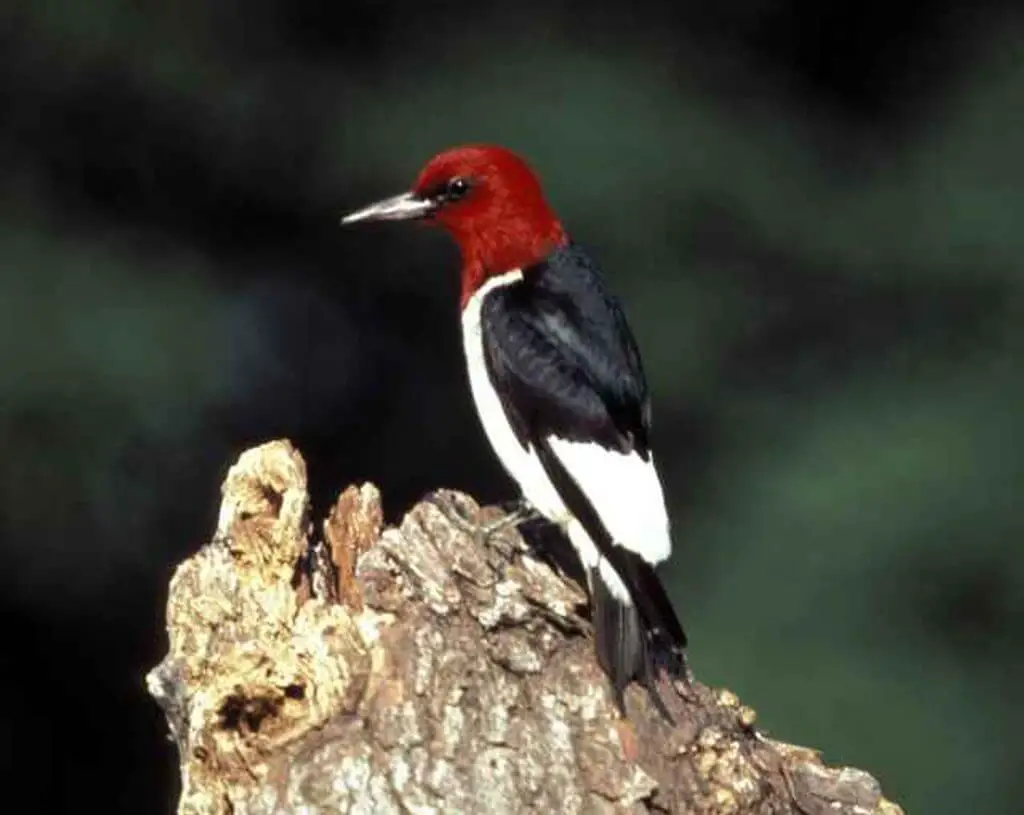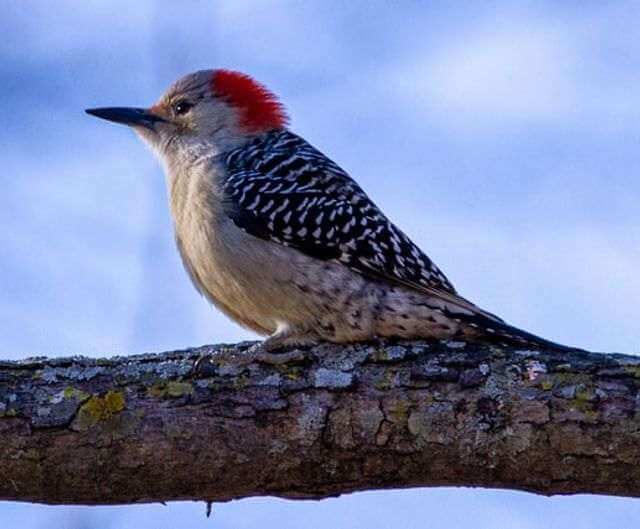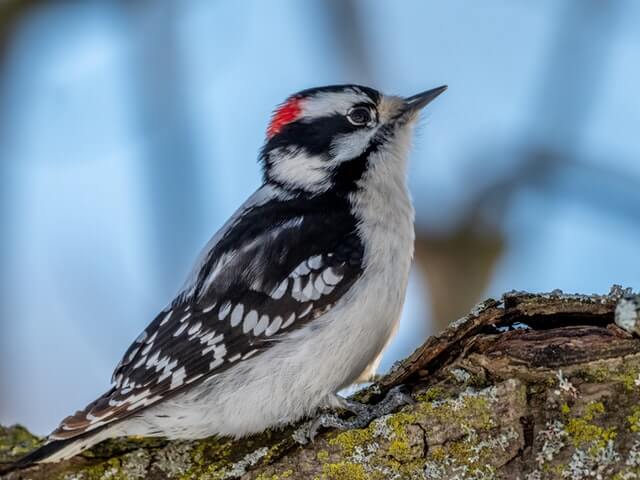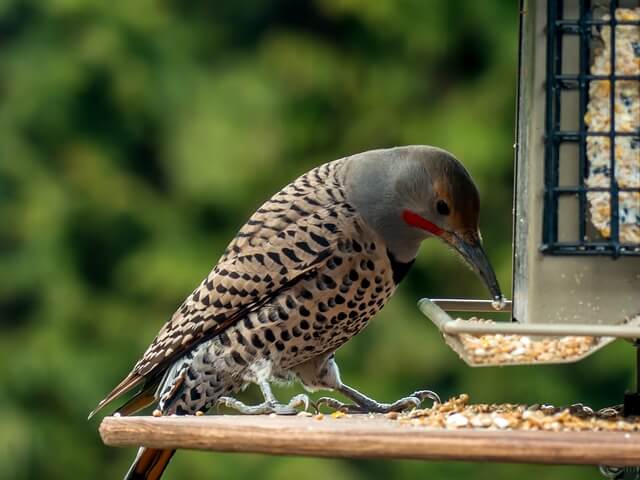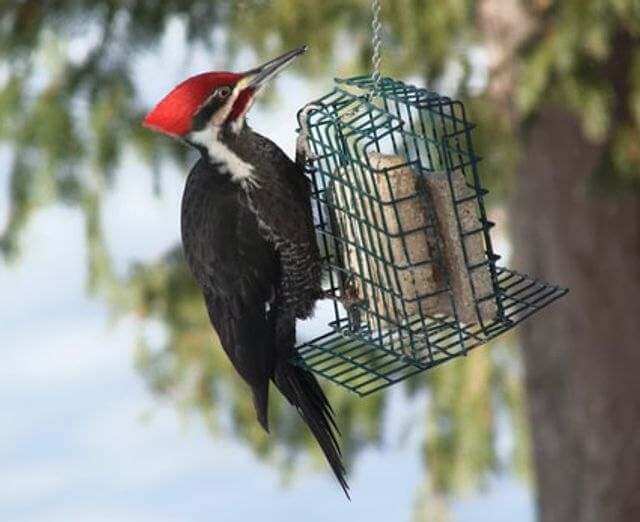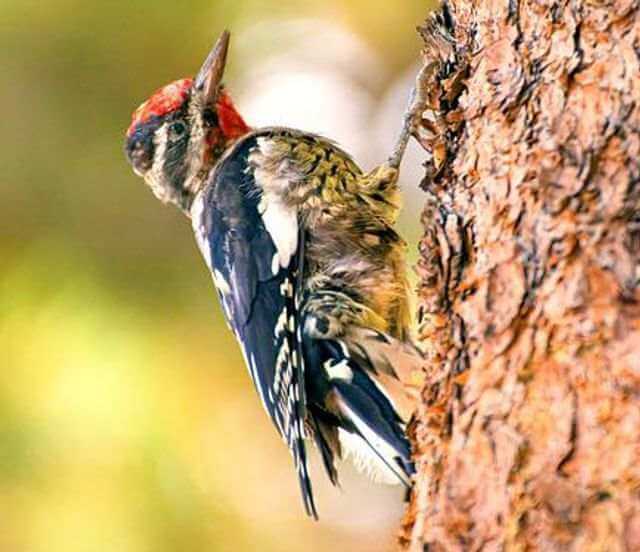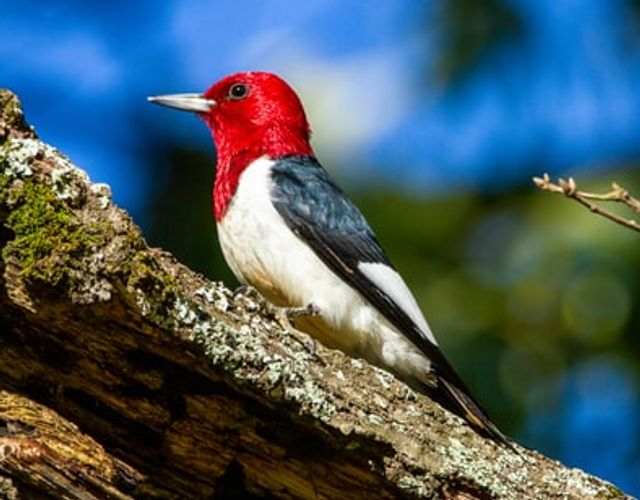Welcome to our comprehensive guide on the 8 types of woodpeckers found in New Jersey! Woodpeckers are captivating birds known for their drumming and pecking behaviors.
In this ultimate guide, we’ll dive into the various species of woodpeckers native to New Jersey, exploring their unique characteristics, habitats, and behaviors.
Whether you’re a birdwatcher, nature enthusiast, or simply intrigued by New Jersey’s wildlife, this guide is your ultimate resource for learning about these remarkable birds.
Types of Woodpeckers in New Jersey
Red-bellied Woodpecker
- Length: 9.5 in (24 cm)
- Weight: 2.0-3.2 oz. (56-90 g)
- Wingspan: 13.0-16.5 in (33-42 cm)
- Scientific Name: Melanerpes carolinus
- Frequency of Occurrence: 33.05% (Statistic by: eBird)
- Where To Find Them: The red-bellied woodpecker can be found in a variety of locations in New Jersey. These birds are most commonly found in the central and southern parts of the state, but they have been spotted as far north as Sussex County and as far west as Warren County. They prefer wooded areas, but will also inhabit urban areas if provided with ample tree cover.
- How to Attract: One way to attract the red-bellied woodpecker is by providing them with food sources that they find attractive. Some good food sources for them include suet feeders, nuts, fruits, and seeds. You can also provide them with bird houses or perches to sit on.
Description: The Red-bellied woodpecker is a common forest bird found throughout North America. The range of this bird extends from southern Canada to Central America, although the majority of their populations can be found in the United States. Red-bellied woodpeckers are mainly woodland birds, but they do inhabit some open areas as well.
They eat mostly insects and small vertebrates, but will also consume nuts, fruits and berries. The red-bellied woodpecker nests in cavities excavated in dead wood or even a nesting box. The typical clutch size is 2-6 eggs incubation period is approximately 12 days and the fledging period is about 35 days.
Related Post: How to Attract Red-bellied Woodpeckers to your Yard?
Downy Woodpecker
- Length: 5.5-6.7 in (14-17 cm)
- Weight: 0.7-1.0 oz. (21-28 g)
- Wingspan: 9.8-11.8 in (25-30 cm)
- Scientific Name: Picoides pubescens
- Frequency of Occurrence: 30.22%
- Where To Find Them: Downy Woodpecker populations have exploded in recent decades, with sightings documented at almost every NJ location from the Appalachian Mountains to the Pine Barrens.
- How to Attract: Place bird feeder in a prominent location near your home. Downy Woodpeckers will love feeding from a high up perch! Hang birdhouses from trees near your home or place them on poles in your yard. Downy Woodpeckers are attracted to bright colors and will often perch inside birdhouses. Try adding some bird baths or water fountains to your landscaping. These features offer cool, wet surroundings that the woodpeckers love!
Description: Downy Woodpecker is a common bird in the northeast. It can be found throughout most of New England, up into southern New York and eastern Pennsylvania, and south to North Carolina, Georgia, and Florida. The downy woodpecker’s distribution range covers much of the eastern half of North America.
It inhabits deciduous and mixed forests, but is most commonly found near water. Downy woodpeckers feed mainly on insects, but will also eat berries, fruit or seeds. The Downy Woodpecker nests in tree cavities excavated by the birds themselves.
Related Post: How to Attract Downy Woodpeckers to Your Yard? (Easy!)
Northern Flicker
- Length: 11.0-12.0 in (28-31 cm)
- Weight: 3.9-5.6 oz. (110-160 g)
- Wingspan: 16.5-20.0 in (42-51 cm)
- Scientific Name: Colaptes auratus
- Frequency of Occurrence: 22.83%
- Where To Find Them: The Northern Flicker is an uncommon bird that can be found in a few locations in New Jersey. The Northern Flicker can be found in the Pine Barrens, the Pinelands, and the Warren Hills.
- How To Attract: Provide a reliable food source. Northern Flickers are attracted to food that is consistent and easy to locate. Try setting up a feeder with fresh fruit or seeds, or adding some birdseed to your garden. Create interesting surroundings. Plant your garden in interesting shapes and add shrubs and trees that provide shelter and prey for the birds. Make sure there is plenty of open space so the birds can fly around freely. Give them some space. Don’t try to keep these birds too close to your house – they need room to fly and forage for food.
Description: The Northern Flicker (Colaptes auratus) is a common bird that can be found throughout the eastern and central United States. The Northern Flicker’s distribution range includes areas of both forest and non-forested land. The bird is most commonly found in areas with deciduous trees, but it is also seen in coniferous forests.
The Northern Flicker’s habitat includes both open areas and wooded areas. The Northern Flicker primarily eats insects, but it will also consume seeds, berries and fruit. The nests of the Northern Flicker are excavated into dead or diseased trees.
Related Post: How to Attract Northern Flickers to your Backyard (Easy)
Hairy Woodpecker
- Length: 7.1-10.2 in (18-26 cm)
- Weight: 1.4-3.4 oz. (40-95 g)
- Wingspan: 13.0-16.1 in (33-41 cm)
- Scientific Name: Picoides villosus
- Frequency of Occurrence: 9.66%
- Where To Find Them: They are most commonly found in the higher elevations of the state, but they have also been spotted in areas such as Hackensack and Saddle River.
- How To Attract: Install a feeder with a variety of food options. Hairy Woodpeckers love to eat small insects, so make sure to include a variety of offerings, including both fruit and insect feeders. Plant trees and shrubs that provide plenty of natural shelter for the birds. These include oak, maple, birch and pine trees. Create a “honeybee” trail by planting nectar-rich plants along your pathways. Include birdhouses in your garden ornaments.
Description: The Hairy Woodpecker is a common bird found throughout North America. The distribution range of the Hairy Woodpecker extends from eastern Canada to South America, and includes all of the United States. The habitat of the Hairy Woodpecker includes both open and wooded areas, including forests, marshes, and swamps.
The diet of the Hairy Woodpecker consists primarily of insects, but they will also eat berries, fruits, nuts and seeds. The Hairy Woodpecker excavates nest holes in dead or diseased trees. They are monogamous birds and usually have one mate for life.
Pileated Woodpecker
- Length: 15.8-19.3 in (40-49 cm)
- Weight: 8.8-12.3 oz. (250-350 g)
- Wingspan: 26.0-29.5 in (66-75 cm)
- Scientific Name: Dryocopus pileatus
- Frequency of Occurrence: 3.98%
- Where To Find Them: The pileated woodpecker is a bird that can be found in many locations across New Jersey. They are most commonly found in areas with tall trees and lots of foliage, such as the Pine Barrens and the Pinelands. While they are not as common in urban areas, they can be spotted occasionally in places like Newark, Jersey City, and Trenton.
- How To Attract: One way to attract the Pileated Woodpecker to your yard is to provide nesting boxes. These birds will use holes in trees or other structures as nests, so providing a box will help them populate your area. You can also try planting trees specifically designed for woodpeckers, or adding flowering plants that offer food sources such as fruit or sap.
Description: The pileated woodpecker is a large bird that can be found in most parts of North America. It has a distribution range that extends from central Canada to southern Mexico and eastward to the eastern United States. This bird is mainly found in deciduous and mixed forests, but it can also be found in coniferous forests, riparian areas, and even urban areas.
The pileated woodpecker is an excavator of its nest hole and will use dead or diseased trees for nesting. It feeds primarily on insects, but it will also eat fruit, berries, seeds and nuts.
Related Post: How to Attract Pileated Woodpeckers to your Yard (Fast)
Yellow-bellied Sapsucker
- Length: 7.1-8.7 in (18-22 cm)
- Weight: 1.5-1.9 oz. (43-55 g)
- Wingspan: 13.4-15.8 in (34-40 cm)
- Scientific Name: Sphyrapicus varius
- Frequency of Occurrence: 3.17%
- Where To Find Them: They can be found throughout New Jersey, but are most common in the Pine Barrens region. The Yellow-bellied Sapsucker prefers to reside in hardwood trees, and is able to adapt well to changing environments.
- How to Attract: If you want to attract the yellow-bellied sapsucker to your backyard, start by planting a variety of trees that provide food and shelter for this bird. You can also try installing bird feeders and making sure there are plenty of places for them to perch. Keep in mind that sapsuckers are territorial birds, so you’ll need to be respectful of their space if you want them around.
Description: The Yellow-bellied Sapsucker ranges across the eastern United States, from southern New England to central Florida. They are common in coniferous and mixed hardwood forests, but can also be found in urban areas.
The Yellow-bellied Sapsucker is a migratory bird, and will fly long distances to find food. They primarily eat arthropods, but will also consume tree sap, fruits, berries and nuts. The Yellow-bellied Sapsucker excavates nest holes in dead or diseased trees, and pairs typically lay 4-6 eggs.
Related Post: 16 Interesting Sapsucker Facts Revealed!
Red-headed Woodpecker
- Length: 7.5-9.1 in (19-23 cm)
- Weight: 2.0-3.2 oz. (56-91 g)
- Wingspan: 16.5 in (42 cm)
- Scientific Name: Melanerpes erythrocephalus
- Frequency of Occurrence: 0.8444%
- Where To Find Them: The red-headed woodpecker can be seen in several locations around New Jersey, such as the Pine Barrens, the Pinelands, and the Highlands.
- How to Attract: In order to attract them to your garden or yard, you will need to make sure that they have plenty of food and water. You can also try installing perches and nesting boxes in your yard.
Description: The red-headed woodpecker is a common bird found throughout the United States. It ranges from the Pacific Northwest to the Gulf Coast, and it inhabits a variety of habitats including coniferous and deciduous forests, chaparral, and urban areas.
The red-headed woodpecker primarily feeds on tree sap, insects, but it also eats fruit. The red-headed woodpecker excavates nest holes in dead or diseased trees. A typical clutch size is 3-10 eggs, that are incubated by the female for about 14 days before they are hatched.
Related Post: Interesting Red-Headed Woodpecker Facts (Explained)
Black-backed Woodpecker
- Length: 9.1 in (23 cm)
- Weight: 2.1-3.1 oz. (61-88 g)
- Wingspan: 15.8-16.5 in (40-42 cm)
- Scientific Name: Picoides arcticus
- Frequency of Occurrence: 0.0001%
- Where To Find Them: Black-backed Woodpecker are fairly common in New Jersey, but they can be found in a variety of locations. These birds are most commonly seen in the Pine Barrens, but they can also be found near creeks and rivers.
- How to Attract: There are several ways to attract these birds to your yard, including providing a feeding station, adding a nest box, and decorating your yard with tree branches that they can use for nesting.
Description: The Black-backed woodpecker is a migratory bird that inhabits most of North America. It ranges from the east coast to the west coast, and it can be found in every state except Alaska. This bird prefers to live in forests, but it will also inhabit suburban areas and even suburbia’s near forests.
The black-backed woodpecker is a generalist feeder and will eat beetle larvae, insects, and other small animals. It excavates hole in dead or diseased trees to build its nest. These birds are monogamous and usually have one mate for their entire life. The black-backed woodpecker typically lays 6 eggs per cycle, but sometimes three eggs are laid.
Frequently Asked Questions
What is the most common woodpecker in New Jersey?
According to Ebird, the most common woodpecker in New Jersey is the red-bellied woodpecker. This bird can be seen at a frequency of occurrence of 33%. Other common woodpeckers that can be found in the state include the downy woodpecker at a (30% frequency), Northern flicker (22% frequency), and the hairy woodpecker (9.5% frequency).
Is it good to have woodpeckers in your yard?
There are pros and cons to having woodpeckers in your yard, but the benefits usually outweigh the costs. Woodpeckers can be a beneficial part of your ecosystem because they help to clear trees and shrubs of unwanted vegetation. They also eat insects, which can damage crops.
On the other hand, woodpeckers can be destructive when they peck holes in your property. If you want them in your yard, be sure to keep an eye on their behavior and take appropriate measures if necessary.
Are there northern flickers in NJ?
Northern flickers can be found in the northeast corner of the state, around Morristown and Wayne. They are also present in areas around Sussex County, such as Hanover and Hope Valley. There are also populations that reside near Warren County, though it is not well-known.
How big are woodpeckers in New Jersey?
The pileated woodpecker, is the largest in New Jersey and the 2nd largest in North America, after the recently extinct ivory-billed woodpecker. The pileated woodpecker can measure almost 20 inches tall with a wingspan of up to 30 inches. The male bird is typically larger than the female and has a red cheek stripe, black body, and white wing bars.
The pileated woodpecker inhabits mainly deciduous and mixed forests throughout New Jersey but is not commonly seen. These birds are specialist insect hunters, prying apart insects hidden within tree bark or under loose bark.
What types of woodpeckers are in New Jersey?
New Jersey is home to a variety of woodpeckers, the red-bellied Woodpecker, downy Woodpecker, Northern flicker, hairy woodpecker, pileated woodpecker, yellow-bellied sapsucker, red-headed woodpecker, black-backed woodpecker can all be found in New Jersey. These birds are known for their drumming and chirping sounds they make, which help them find food and mates.
Related Post: 62 Most Common Backyard Birds In New Jersey (Detailed)

